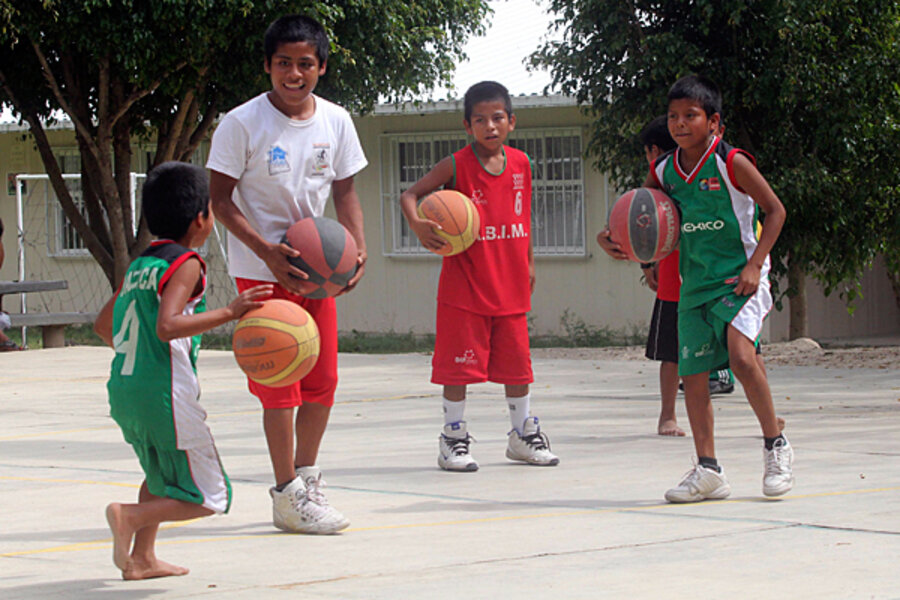Is basketball now a rising star in soccer-loving Mexico?
Loading...
| NOGALES, MEXICO
Soccer may be king of sports in Mexico, but the rising popularity of basketball is giving fútbol a kick in the shin.
"We're seeing a new wave of young people showing great interest in basketball," says Jaime González Rodriguez, director of the municipal sports institute in Nogales.
Mr. González Rodriguez points toward dozens of teens dribbling and shooting hoops in a gym at a sports complex here in the border state of Sonora. At a special basketball clinic, the youngsters share the court with former Phoenix Suns players Tom Chambers, Steven Hunter, Tim Kempton, and Horacio Llamas, the National Basketball Association's (NBA) first Mexico-born player.
The NBA is working to extend its reach into Mexico. In December, the San Antonio Spurs will go up against the Minnesota Timberwolves in Mexico City –marking only the second regular-season game to be played there. The timing of the NBA's foray south of the border comes just as a basketball buzz is gripping Mexico.
While Mexico's beloved national soccer squad struggles, its basketball team is making history. Having pulled off an improbable championship run at the International Basketball Federation (FIBA) Americas, the team heads to the FIBA World Cup in Spain next year. Mexico last appeared in the basketball tournament in 1974.
Then there's Mexico's "barefoot team."
Earlier in October, a group of Trique Indian boys from the southern state of Oaxaca dominated the International Festival of Mini-Basketball and eventually emerged as champions in the Argentina venue. As the name suggests, the games allow children to play on smaller courts with shortened hoops.
The team earned its nickname because most of the boys play barefoot, despite having sneakers provided for them. Most were not used to playing in shoes because their families can't afford them. The boys earned acclaim from various corners of the world.
The boys' incredible feat, no pun intended, not only serves to inspire other kids in Mexico and Latin America, but is also a boon to the sport, González Rodriguez says.
"Things seem to be falling into place," he says. "Now we are demonstrating the value of basketball in Mexico."
The director recalls that basketball reigned in Nogales for decades. But over time soccer rose to the top. From the 1960s and through the '80s, the city was known as "the cradle of basketball," Mr. Rodriguez says. Soccer long has had an official presence in Mexico. The country participated in the first World Cup soccer match in 1930, but it wasn't until after the country hosted the 1970 World Cup that soccer exploded in the streets and became a national obsession.
But inside the local gym hosting the NBA clinic, basketball is best. At least according to Andrés Borboa and Marco Antonio Osorio, both 13-year-olds who play on the same basketball team. "I like everything about basketball," Marco says.
The boys say they learned valuable techniques from the Suns that they will put to the test at their next game. They admit to knowing little about the Suns stars working with them today, saying they're more familiar with players such as Kobe Bryant, LeBron James, and Kevin Durant.
But they know about Mr. Llamas. "He has inspired me, because like him, I also want to make it to the NBA," Andrés says.
Llamas, who made a name for himself in the Mexican league before playing his first game with the Suns in 1997, says he was honored to be part of the event in a place that's part of his basketball career. "I played in Nogales many years ago," he says.
Llamas is flattered that kids born long after he played in the NBA know who he is. He says this shows that an interest in basketball can prove a positive influence and help kids steer clear of trouble. "So many bad things are said about our country, but a lot of good things are also happening," Llamas says, referring to the many youngsters who dedicate time and effort to sports. "We need to pay more attention to the good things."







